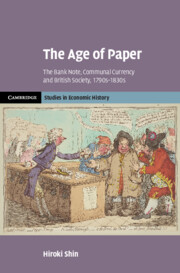Book contents
- The Age of Paper
- Reviews
- Cambridge Studies in Economic History
- The Age of Paper
- Copyright page
- Contents
- Figures and Illustrations
- Tables
- Acknowledgements
- Abbreviations
- Introduction
- 1 The Beginning of the Bank Restriction Period
- 2 The Users of the Bank of England Note
- 3 The Registers of Paper-Currency Use
- 4 Gold, Gold, Gold
- 5 The Forgery Crisis and the Radicalisation of Communal Currency
- 6 Resumption and Its Aftermath
- Conclusion
- Bibliography
- Index
6 - Resumption and Its Aftermath
Published online by Cambridge University Press: 19 December 2024
- The Age of Paper
- Reviews
- Cambridge Studies in Economic History
- The Age of Paper
- Copyright page
- Contents
- Figures and Illustrations
- Tables
- Acknowledgements
- Abbreviations
- Introduction
- 1 The Beginning of the Bank Restriction Period
- 2 The Users of the Bank of England Note
- 3 The Registers of Paper-Currency Use
- 4 Gold, Gold, Gold
- 5 The Forgery Crisis and the Radicalisation of Communal Currency
- 6 Resumption and Its Aftermath
- Conclusion
- Bibliography
- Index
Summary
Chapter 6 traces the last years of Britain’s communal currency. From the chapter’s examination of the resumption debate, it emerges that the decision on resumption stemmed from loss of faith in inconvertible currency and the fractured state of British society, rather than from unanimous support for the theory or policy of the gold standard. This chapter reveals that the supporters of resumption were a mixed group of people, including those with metallist and non-metallist views alike. The anti-resumption campaign lacked coherence, but ultimately it was the fractured state of British society that made inconvertible currency unsustainable: Britain’s note users no longer saw themselves as a single community of money users but as competing groups with different economic interests. The rest of the chapter illustrates the process by which the remnants of communal currency were gradually chipped away in the following twelve years, which were punctuated by major events such as the financial crisis of 1825 and the political run on the Bank of England in 1832. This chapter closes in 1833, when the fate of currency voluntarism was finally sealed as the Bank note became legal tender.
- Type
- Chapter
- Information
- The Age of PaperThe Bank Note, Communal Currency and British Society, 1790s–1830s, pp. 235 - 269Publisher: Cambridge University PressPrint publication year: 2025

